“Pravara Tent”- An Innovative Protective Device to Control Aerosol in Dental Clinics during the COVID-19 Pandemic
Deepak Macchindra Vikhe1, Summit V Dhope2, Prasad N Mhaske3, Seemit V Shah4, Umesh G Palekar5
1 Reader/Associate Professor, Department of Prosthodontics, Rural Dental College, Pravara Institute of Medical Sciences (DU), Pravara Medical Trust, Loni, Maharashtra, India.
2 Lecturer, Department of Prosthodontics, V.Y.W.S Dental College and Hospital, Amarvati, Maharashtra, India.
3 Senior Lecturer, Department of Prosthodontics, Bharati Vidyapeeth University Dental College, CBD Belapur, Navi Mumbai, Maharashtra, India.
4 Professor and Head, Department of Oral and Maxillo Surgery, Rural Dental College and Hospital, Pravara Medical Trust, Loni, Maharashtra, India.
5 Professor and Head, Department of Prosthodontics, Rural Dental College and Hospital, PIMS, Pravara Medical Trust, Loni, Maharashtra, India.
NAME, ADDRESS, E-MAIL ID OF THE CORRESPONDING AUTHOR: Dr. Deepak Macchindra Vikhe, Reader/Associate Professor, Department of Prosthodontics, Rural Dental College and Hospital, Pravara Institute of Medical Science (DU), Pravara Medical Trust, Loni-413736, Maharashtra, India.
E-mail: drdeepak_mvikhe@yahoo.com
Many dental procedures use modern devices like an air rotor and ultrasonic scaler, which generate aerosols and droplets. The dental procedures cannot be performed without the above devices. The ways commonly available today to control aerosols are suction, saliva ejectors, but it does little to control aerosols. The expensive filters like High-Efficiency Particulate Air (HEPA) are available but they are not easily available in rural set-up and economical for everyone. There are many diseases, for example- severe acute respiratory syndrome, tuberculosis, influenza and viral infections, which spread through droplets, so management of the infection control procedures for aerosols is mandatory in dental clinics. A novel human coronavirus-that is, Severe Acute Respiratory Syndrome Coronavirus 2 (SARS-CoV-2) also can be transferred through droplets and splatter. The COVID-19 pandemic has led to the manufacturing of novel devices to protect the dentist from the risk of transmission. The “Pravara tent” (the name Pravara was given to the tent by the authors as it was invented at the place called Pravara) is one of the examples of a protective (box) device, which can be used to control aerosols generated from air rotor and an ultrasonic scaler to reduce transmission of diseases between clinicians, and the patients. So, this tent is a simple, modified, and economical innovative protective device working with high efficacy by creating a barrier between patient and dentist to minimise aerosols during dental procedures.
Airborne, Droplets, Dental procedures, Innovative, Infection control, Novel, Transmission of diseases
Introduction
The living organisms release certain airborne particles of liquid or volatile compounds, which are referred to as aerosols. It has been recognised that the consequences of many dental procedures produce bioaerosols in microdroplets and represent a potential mechanism for spread of infection [1]. In dentistry, pathogens come from mainly two sources: water lines in the dental clinic and patient itself. Dental procedures use modern devices like an air rotor, and ultrasonic scaler, which generate aerosols and droplets. A review by Harrel SK et al., found that a hundred percent of samples collected of aerosols and splatter during ultrasonic scaling contained blood, according to this review, as aerosols contain blood it can be a source of infections [2]. With arrival of different diseases like severe acute respiratory syndrome, questions concerning the potential for the spread of infections through this aerosol may arise [3]. Average particle size of coronavirus particles ranges around 0.125 microns, and give appearance of “coronas” around the sun with distinctive spikes of 9 to 12 nanometers. The human airway epithelial cell death is observed after 96 hours of inoculation on its surface [4]. According to Occupational Safety and Health Administration, the occupations that are involved with aerosol production fall into category of very high risk. Since dentistry falls under this category, the section “Implement Workplace Controls, Engineering Controls” recommends that dental practices install negative-pressure rooms or airborne infection isolation rooms for operatories in which procedures involving aerosol will be performed [5]. Dental practice all over the world is affected by current COVID-19 (Coronavirus Disease-2019) pandemic. This novel COVID-19 mainly spreads and transmits between human-to-human via respiratory droplets and contact [6]. So, there should be preventive measures to control aerosols and splatter in dental practice other than the routine measures. The manufacturing of novel devices, to minimise aerosols and to protect dentists from the risk of transmission in this COVID-19 pandemic is the primary aim of the researchers, one of the examples is the aerosol box for use in intubation [7]. To manufacturer this type of aerosol box, needs high-grade expensive acrylic sheets with different tools to cut it with precision, they are difficult to disinfect, and their raw material is not easily available. In comparison to above aerosol box, the Pravara tent is economical, can be easily made with polyvinyl chloride pipes. It is a modified design of previously used aerosol box.
Pravara Tent
This tent is an attempt to reduce the aerosols and reduce the risk of cross-infection, exposure between patients and clinicians during this COVID-19. The tent was named-Pravara, as it was modified and named by authors at placed called Pravara hospital. Pravara tent is made of a disposable clean wrap plastic wrapping paper, PVC-Polyvinyl chloride (Astral Poly Technik ltd.,), pipe framework covering the patient from head to chest area, with the attachment for the drape providing further coverage [Table/Fig-1,2].
Required materials for pravara tent assembly.
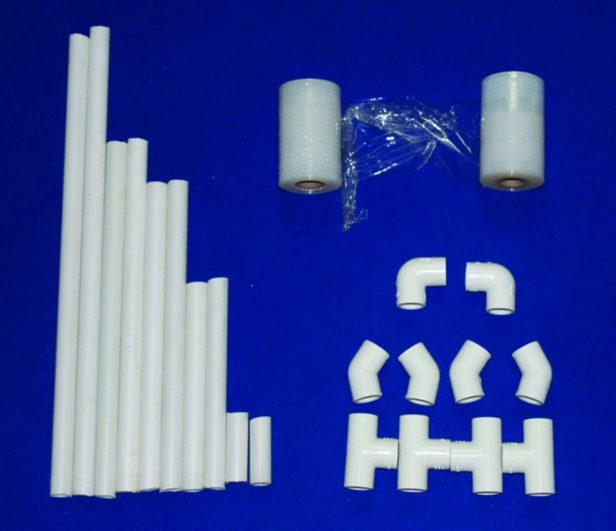
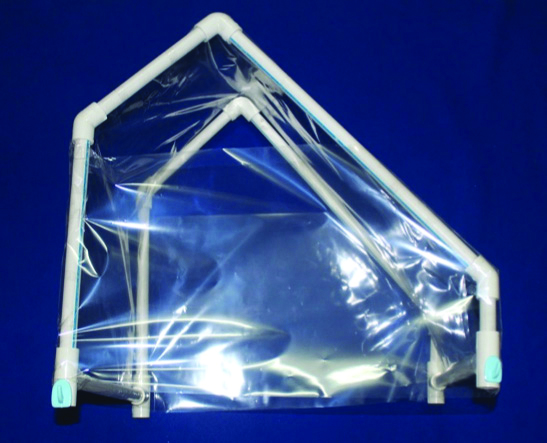
The dimensions of the tent are base width is around 40 cm to accommodate shoulder of patient, height on side of patients head is around 38 cm to accommodate the head of the patient and angle or bend is given on the upper roof part of the tent to accommodate hands of the operators (bend is 23 cm towards the patient head and 50 cm towards the chest of a patient), the height of the tent towards patients chest is around 15 cm. The additional features that can be added to the tent are like hangers for drape, suction. To attach an aerosol suction device to absorb the droplets and splatter, an extra 4 cm hole can be made on the top surface of the hood of the tent. The transparent sheet covering the tent will have two circular working openings on the side [Table/Fig-3].
Dimensions of the framework of pravara tent.
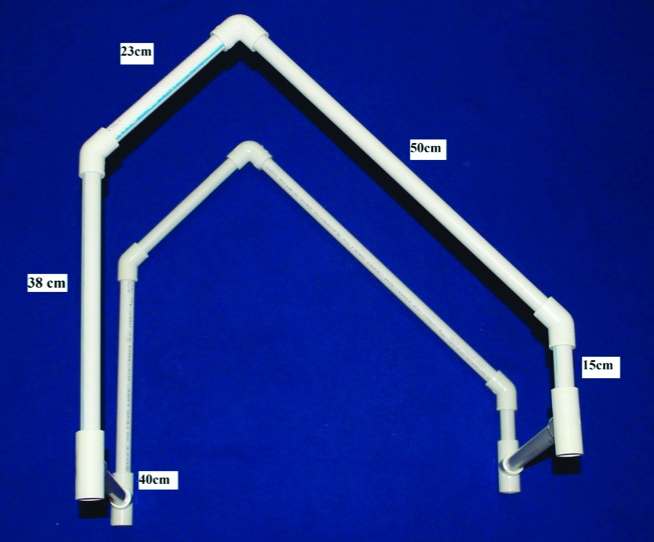
This tent is simple in design, easy to assemble, economical as it is made up of cheaper PVC pipes, and has modified design of previously used expensive aerosol boxes [8]. The design of the tent has a reduced base size so that it will have a proper gap of 25 cm between spittoon and armrest for proper adaptation of tent [Table/Fig-4]. The tent due to simple design with transparent disposable is clear to see through with details and has self-closing access points, allowing easy hand access in and around the patient’s airway, with a full line of sight for dental staff [Table/Fig-5]. After every patient, the transparent wrap paper is disposed and the frame can be cleaned and autoclaved with precautions like proper temperature (steam at a pressure of about 15 psi, attaining temperature of 121°C), as they withstand up to 70-90 autoclaving cycles. Dentists can have multiple tents in their clinics as material required for a tent is easily available and economical. Assembly of the tent consists of PVC pipes of proper measurements and clear transparent wrap paper [Table/Fig-1,2]. It takes less time to assemble, significantly lighter in weight (approximately around 250-300 gms), cheaper than hard box solutions, and is easy to dis-assemble for transportation, storage, and disposal in standard waste bins. The prototype of this tent was tried at the Pravara Institute of Medical Sciences, rural dental college with dental staff and conducted the aerosol-generating dental procedures, like scaling by ultrasonic, endodontic procedures, tooth prepration to receive crown [Table/Fig-6]. All reported that this tent is safe, comfortable, and easy to install in a rural set-up. It will be helpful in all kinds of dental treatments like endodontic procedures, ultrasonic scaling, tooth preparations and patients with asthma or medical problems as its design consist of an access opening for working hands. In the rural set-up of dental clinics, due to limited resources, this tent will be of great help.
Pravara aerosol tent placed on the dental chair.
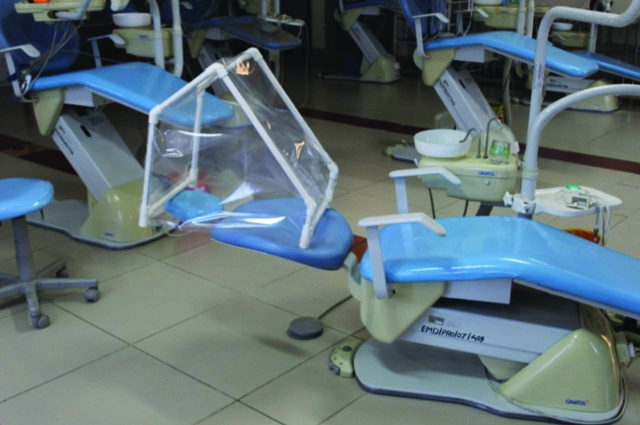
Patient on the dental chair with an aerosol tent in position.
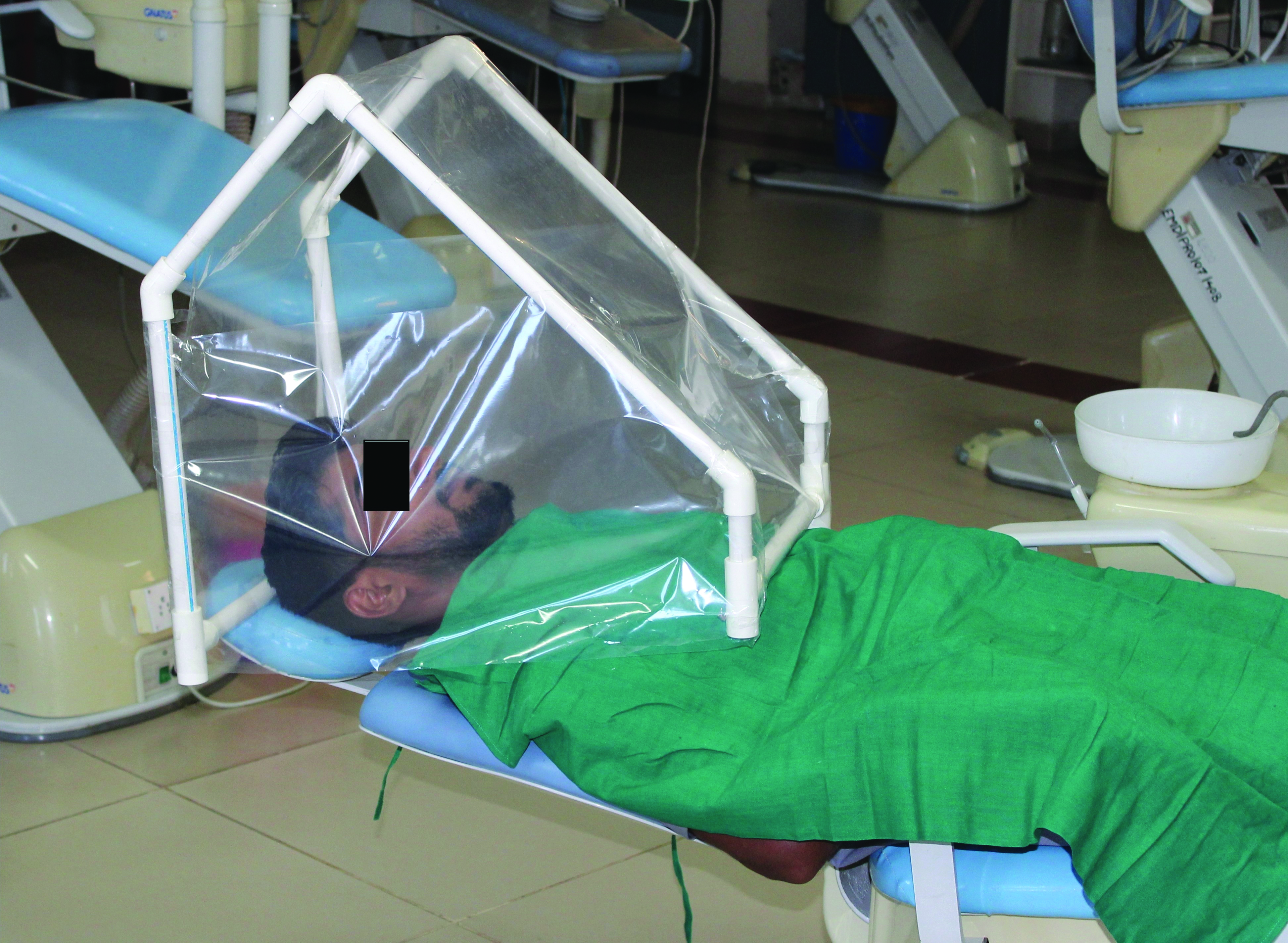
Patient on the dental chair with an aerosol tent in position.

Limitation(s)
The drawbacks of this tent are, that it will increase dental treatment time, some discomfort to the patient with restricted movement initially and obstruct the way to dental procedures like minor surgeries (disimpactions, mandible fracture cases, periodontal flap surgeries).
Conclusion(s)
This COVID-19 pandemic has caused dentist and their associates to fear for their personal safety in clinics during working due to aerosols generated by many dental procedures. This “Pravara Tent” is an Innovative novel protective device, which can be used to control aerosols generated from air rotor and an ultrasonic scaler to reduce transmission of diseases between clinicians, patients. This tent is a simple, modified, and economical.
Author Declaration:
Financial or Other Competing Interests: None
Was Ethics Committee Approval obtained for this study? NA
Was informed consent obtained from the subjects involved in the study? NA
For any images presented appropriate consent has been obtained from the subjects. NA
Plagiarism Checking Methods: [Jain H et al.]
Plagiarism X-checker: Jun 10, 2020
Manual Googling: Aug 10, 2020
iThenticate Software: Oct 17, 2020 (4%)
[1]. Hallier C, Williams DW, Potts AJC, Lewis MAO, A pilot study of bioaerosol reduction using an air cleaning system during dental proceduresBr Dent J 2010 209(8):E14:1-4.10.1038/sj.bdj.2010.97520953167 [Google Scholar] [CrossRef] [PubMed]
[2]. Harrel SK, Barnes JB, Rivera-Hidalgo F, Aerosol and splatter contamination from the operative site during ultrasonic scalingJ Am Dent Assoc 1998 129(9):1241-49.10.14219/jada.archive.1998.04219766105 [Google Scholar] [CrossRef] [PubMed]
[3]. Harrel SK, John Molinari DDS, Aerosols and splatter in dentistry A brief review of the literature and infection control implicationsJADA 2004 135(4):429-37.10.14219/jada.archive.2004.020715127864 [Google Scholar] [CrossRef] [PubMed]
[4]. Zhu N, Zhang D, Wang W, Li X, Yang B, Song J, A novel coronavirus from patients with pneumonia in China, 2019N Engl J Med 2020 382(8):727-33.10.1056/NEJMoa200101731978945 [Google Scholar] [CrossRef] [PubMed]
[5]. Guidance on preparing workplaces for COVID-19. US Department of Labor. Occupational Safety and Health Administration. 2020. https://www.osha.gov/Publications/OSHA3990.pdf [Google Scholar]
[6]. Balaji SM, COVID-19-Future of dentistryIndian J Dent Res 2020 31(2):167-68.10.4103/ijdr.IJDR_347_2032436891 [Google Scholar] [CrossRef] [PubMed]
[7]. Begley JL, Lavery KE, Nickson CP, Brewster DJ, The aerosol box for intubation in coronavirus disease 2019 patients: An in-situ simulation crossover studyAnaesthesia 2020 75(8):1014-21.10.1111/anae.1511532397008 [Google Scholar] [CrossRef] [PubMed]
[8]. Babu B, Gupta S, Sahni V, Aerosol box for dentistryBr Dent J 2020 228(9):66010.1038/s41415-020-1598-332385437 [Google Scholar] [CrossRef] [PubMed]